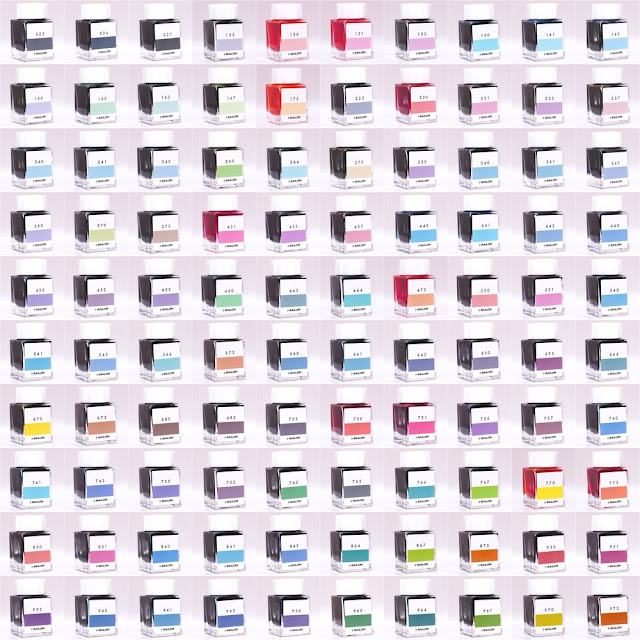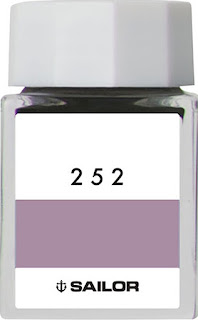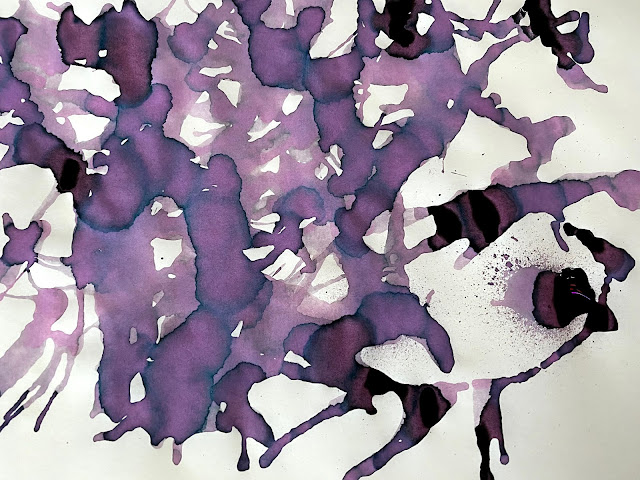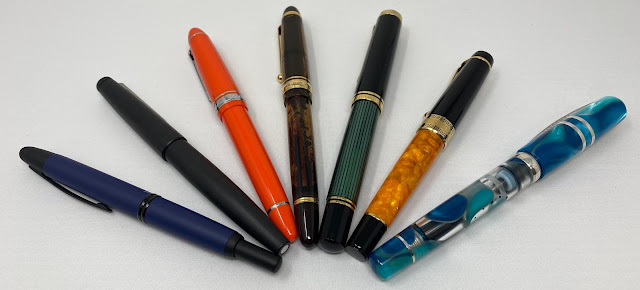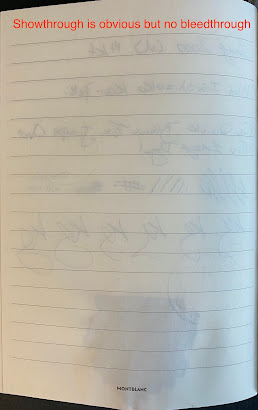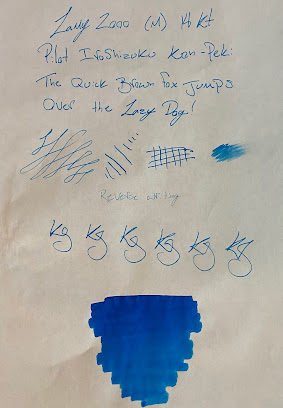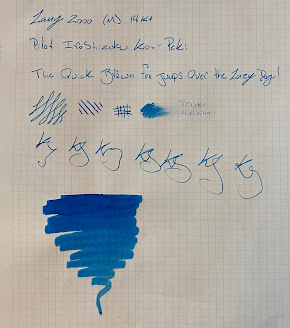Wednesday, December 23, 2020
Taking a look at the most interesting ink in my collection!
Wednesday, October 21, 2020
Fountain Pen Day 2020 Handwriting Competition
Fountain Pen Day 2020 Handwriting Competition
Did you grow up in schools with draconian penmanship standards? Did you spend hours getting your cursive just right? Have you ever been complimented on your print? Now is your time to shine. To celebrate Fountain Pen Day on November 6th, Pen Boutique is holding a handwriting competition! If you think you have good handwriting, get out your favorite fountain pen and submit a handwriting sample. We'll have prizes for best cursive, best print, best under 15, and best in show. Submissions are open until November 6th, so enter as soon as possible and show us what you can do!
Each participant can make one entry for print and one entry for cursive. To enter, send us a handwriting sample with a 50-100 word passage of your choice, and the pen and ink you used. We'll be accepting submissions via DMs, tagged posts on Instagram, and email.
| An example submission |
Friday, October 2, 2020
Coming Soon: Punilabo Pen Cases
Punilabo Pen Cases
Coming in soon are these adorable Punilabo Pen Cases!
There are 10 different animal options available:
Penguin, Parakeet, Boston Terrier, Calico Cat, Panda, Pig, Gray Cat, Black Cat, Shiba Inu Dog, and Brown Bear.
These are silicone cases that are easy to cary and can easily transform into a pen cup for your desk! The bottom of the case pops up when you press it down on a desk, lifting the contents and making them easy to pick through.
They are also water resistant and easy to clean.
You can use them for almost anything -- pens, pencils, cosmetics, accessories, etc up to 6.5".
We should be getting them in next week, so keep an eye out for them!
Wednesday, September 23, 2020
Ready to take the next step in the fountain pen world?
So, What's Next?
Nibs:
Materials:
Filling Systems:
Best Next Step Pens:
- Pilot Vanishing Point- This is quite a unique looking pen because it has a retractable nib similar to a ballpoint pen. The pen also has a gold nib on it that is on the small side but is still a pleasure to write with! The click action to activate the nib really makes this a convenient pen for note taking and quick on the spot writing because you don't have to unscrew and hold a cap, Pilot also made sure that this pen had both convenience and quality as opposed to sacrificing one for the other. These pens come at a reasonable price as well, you are looking at something between $144-$156 which puts it right in that "first gold nib" price point. You can also buy different nib units to switch out if you don't want to amass a large collection but still want gold nib choices.
- Lamy 2000- This is also often cited as the best "starting gold nib" right alongside the vanishing point but the two pens are very different. They do share a similarity in that they both have rather small nibs with the Lamy's being a hooded nib. This means the nib is partially in the section which keeps the nib very wet and supplies it with a sufficient amount of ink. The 2000 is a piston filler and has its own ink window, it also has a large ink capacity which makes the ink window helpful. The design of the 2000 is also quite unique and has barely changed in over 60 years, originally designed with the Bauhaus principles of design, this pen has been displayed in the MOMA in New York. This pen is a little more expensive than the VP at around $200 but comes with a bigger ink capacity and is a piston filler so I still feel the price is quite reasonable for someone's first gold nib but would also be an excellent choice for someone to add to their collection of gold nibs.
- Sailor 1911L- The Sailor pen company is the oldest out of Japan and the 1911 is an homage to the brand's beginnings from their first yea. This is a classic looking cigar shaped pen with an exceptional nib on it. Sailor makes all of their nibs in house and on the larger size of their pens they use 21kt gold for their nibs which is a fairly unique gold to use for fountain pen nibs. These are cartridge converter pens which makes them very easy to clean and maintain, the cartridge also allows for easy and fast ink replacement on the go. If you want something a little more classic looking with some fun color options this would be a good choice for you. The price on these ranges from $180 for the smaller size with a 14kt nib and $312 for the larger size with the 21kt, some colors may also be different prices in-between $180-$312 so keep your eyes peeled for that.
- Pilot Custom 823- One of the pens in the custom line, the 823 is a beautiful amber colored demonstrator and also comes in a smoke color. The ink capacity on these pens is super big and the double reservoir cut off makes it a good option for travel because it minimizes leakage. This pen is also equipped with a vacuum filling mechanism which is very unique and cool to see in a pen of this price range. The pen has Pilot's second largest nib, #15, and is one of my smoothest writers I own, it just glides across the page and is a pleasure to write with. The pen is also a good length and I find the weight to be very nicely balanced. Speaking of price, this pen clocks in at $288 which is quite a nice price for what you get which is a professional looking cigar shaped pen with a unique filling system and wonderful gold nib!
Best Introductions to Pens Over $500:
- Pelikan M1000- As the flagship model for Pelikan and their M line, this pen is oversize and delivers one of the best writing experiences for pens in my own personal collection. The pen itself has a very classy look especially with the green stripe finish. The nib is massive and is beautifully springy, laying down quite a nice wet line that is super satisfying to write with. The piston on this pen is very high quality and smooth which adds a very nice balance to the pen. In-between the green stripes is actually see through which acts as an ink window, I find this is quite a unique way to add an ink window that otherwise may have broken up the design too much. Another fun part of this pen is that the clip is actually designed to look like a pelican's beak and eyes which is just a nice fun touch to a luxurious looking pen. This pen is the flagship pen of the brand and commands a flagship price that tends to vary from each authorized retailer, at Pen Boutique the pen is being offered for $788 and I have absolutely no regrets about buying mine!
- Aurora Optima- Don't let the size of this pen throw you off, Good things do come in small packages with this pen being no exception. This was the first pen I owned with an ebonite feed and the writing experience is nice and smooth, never once have I had a problem with ink flow or skipping/hard starting which is definitely worth mentioning. The nib itself is one of my favorite however it is not nearly as springy as the Pelikan and functions more as a reliable writer that is very uniform in the lines it makes. The cap band also has a sort of vintage look with the greek key pattern surrounding the brand name which I think makes the pen look very visually balanced. One of the other main draws I had to this pen was the large ink window that is very well done and doesn't break up the design or throw it off like some ink windows can, it is very elegant looking if that makes sense. This pint size powerhouse is available in a multitude of colors for a price range of $476-$1,000 as the special editions and sterling silver editions command a higher price.
- Visconti Homo Sapiens- This is quite possibly one of the most unique pens on this list but at first glance you may think it just looks like a black pen. The Visconti HS uses a mix of resin and basaltic lava rock from Mt. Etna in Italy which is very unique. This also makes the material a little more porous so it will actually slightly absorb oils and water from your hand which will make the pen take on it's own personality. The trim varies but my favorite is the Bronze Age which has brass trim, again, this will also patina over time making each pen unique to its owner. The pen is also a vacuum filler which is fun and has a massive ink capacity which makes it a nice daily writer. The nib is 18k and writes wonderfully smooth and is overall a very pleasant experience. The price on these ranges, the lava rock models are generally around $620-$684 with limited edition resin models and lava models with ink windows around $796-$920 and for that price you are getting a very unique pen that is sure to be a reliable daily writer.
Conclusion:
Friday, September 18, 2020
Egyptomania
Montblanc Heritage Egyptomania
Appearance & Packaging:
Nib & Performance:
Pros:
- Very nice nib design
- Satisfying weight and length in the hand
- Cool threading at the end of the section
- Piston filler
Cons:
- Skinny and slightly slippery section. ( some people may not like it).
- Base model may be a little toned down for some in terms of design
- On the expensive side for what it is
Price & Conclusion:
Standard Collection:
Doue Collection:
Friday, September 4, 2020
Back to the Future with the Esterbrook J.R.
Esterbrook J.R.
Color: Capri
Specs:
- Description: A compact revival of one of Esterbrook's most important designs
- Nib: Stainless Steel
- Material: Turned Acrylic
- Filling Mechanism: Cartridge / Converter
- Weight: 20 grams posted, 11 grams un-posted
- Measurements: 5 inches capped, 4.62 inches uncapped, 6 inches posted
History:
Appearance & Packaging:
Nib & Performance:
Pros:
- Beautiful turned acrylic
- Nice to see a brand revive an important model from it's past
- Nice build quality with a high quality feel
Cons:
- Section is pretty short
- Lightweight for a pocket pen when compared to an Alsport which is less expensive
- The price point is on the higher side in my opinion but is still in the realm of reasonable when you take everything about this pen into account.
Price & Conclusion:
Monday, August 31, 2020
It's a bird! It's a pen! It's the Pilot Falcon!
Pilot Falcon
Color: Red with silver toned trim
Specs:
- Description: A lightweight pen with a unique looking semi-flex nib
- Nib: 14kt gold Semi-flex nib
- Material: lightweight resin
- Filling Mechanism: Cartridge / Converter
- Weight: 10 grams uncapped, 19 grams posted
- Measurements: 5.4 inches capped, 5.9 inches posted
- Ink Capacity: .87ml converter
Appearance & Packaging:
Nib & Performance:
Pros:
- Interesting and unique nib and feed system
- Good value for a gold nib at around $150
Cons:
- Price increasing by 15% on Sept. 1st
- very light in the hand especially unposted
- Con-40 is hard to get a good fill with
- Competing with other very good "starter" gold nib pens
Price & Conclusion:
Wednesday, August 26, 2020
Paper. Whats the Difference? What to choose?
Introduction:
Let's meet our competitors:
- Rhodia- Arguably the most accessible brand I'll be comparing is Rhodia as they are available in an abundance of different types of stores, I've even seen them available in art stores and craft stores. The Rhodia brand offers a wide variety of sizes on 80 gsm paper and sometimes even 90 gsm paper however the 80 gsm seems to be more common. In 1997 Rhodia was purchased by Clairfontaine (another brand I'll be comparing later on) but some of the founder's family stayed on with the brand after this purchase, all Rhodia pads are made in France just like in 1932 when the brand was founded and still known as the Verilhac Brothers.
- Clairefontaine- Another staple of French paper manufacturing is Clairefontaine who, as I mentioned earlier, acquired Rhodia relatively recently in 1997. Clairefontaine has been making paper in France for over 150 years and actually started their production in 1858. Unlike Rhodia, Clairefontaine is primarily offered in 90 gsm paper this means it will be a tiny bit heavier than the Rhodia paper. The paper comes in a couple different sizes but not as many unique sizes that a company like Rhodia provides, more of the usual spiral bound or cloth bound sizes.
- Montblanc- Next we have a company that really needs no introduction, whether you are just starting your journey into the fountain pen hobby or are a seasoned veteran, you've heard of Montblanc. Arguably the most famous pen company in the world, Montblanc not only makes pens but also makes notebooks that are leather bound with 85 gsm paper sheets. While they are more expensive, these notebooks aren't really meant for everyday note taking, in my mind they are meant for something like journaling or an activity that you want to keep a record of due to the high build quality and high end materials.
- Tomoe River- If you ask any fountain pen user their favorite type of paper there's a fairly good chance they'll answer with Tomoe River paper. Tomoe River paper used to be quite hard to get with only 1 or 2 vendors in the United States having it but is now widely coveted and available in the United States. The paper is unusually thin for fountain pen paper and is offered in 52 gsm and 68 gsm which are also relatively low for fountain pen paper. Despite the thin profile of each sheet, it handles fountain pens beautifully and really stands out amongst other brands due to the uniqueness of the product at hand. PenBoutique carries the Sakae Technical version of the loose sheets in A4 size in both plain and dot grid. It also comes in a pad or cloth bound notebook closer to an A5 size. This paper's lightweight feel isn't for everyone and some people opt for a thicker paper which is understandable because it takes some getting used to if you are used to writing on higher gsm papers.
- Mnemosyne- Like Tomoe River paper, Mnemosyne is also a Japanese brand that offers exceptional experience while writing with a fountain pen. The paper is manufactured by Maruman and comes spiral bound in a variety of sizes and paper types including grid, plain and lined, the paper's weight is 80 gsm. This is a particularly good line of products for students and business people because each page has a dedicated space for a title and date making it good for taking notes in class or a meeting. The Maruman brand has been in the business for over 90 years and their dedication to the quality of their product is reflected in this fact.
- Write Notepads- the last brand that will be included in this comparison is a local company from Baltimore that makes quality notebooks out of environmentally friendly materials like vegetable based dyes, premium cover stock and 110 gsm paper. The heavy paper makes these notebooks a good option for drawing as well as note taking. Most of their offerings are spiral bound but they also have a classic hardcover version of a notebook as well. The brand is an off shoot of a book binding company and their three generations of expertise in the subject shine through in the quality and craftsmanship of their notebooks.
Putting Them to the Test:
Show through/Ghosting:
|
Brands |
Show-Through |
Feathering |
Dry-Time |
Paper Texture |
Price |
|
Rhodia |
Low |
|
|
|
|
|
Clairfontaine |
Medium |
|
|
|
|
|
Montblanc |
High |
|
|
|
|
|
Tomoe River |
High |
|
|
|
|
|
Mnemosyne |
Low |
|
|
|
|
|
Write Notepads |
Low |
|
|
|
|
Feathering:
Brands | Show-Through | Feathering | Dry-Time | Paper Texture | Price |
Rhodia | Low | light | |||
Clairfontaine | Medium | light | |||
Montblanc | High | light | |||
Tomoe River | High | light | |||
Mnemosyne | Low | light | |||
Write Notepads | Low | light |
Dry Time:
Brands | Show-Through | Feathering | Dry-Time | Paper Texture | Price |
Rhodia | Low | light | medium | ||
Clairfontaine | Medium | light | low | ||
Montblanc | High | light | low | ||
Tomoe River | High | light | medium | ||
Mnemosyne | Low | light | low | ||
Write Notepads | Low | light | low |
Paper Texture:
Brands | Show-Through | Feathering | Dry-Time | Paper Texture | Price |
Rhodia | Low | light | medium | 80-90 gsm / smooth | |
Clairfontaine | Medium | light | low | 90 gsm / smooth | |
Montblanc | High | light | low | 85 gsm / smooth | |
Tomoe River | High | light | medium | 52-68 gsm / smooth but thin | |
Mnemosyne | Low | light | low | 80 gsm / smooth | |
Write Notepads | Low | light | low | 110 gsm / very smooth |
Price $-$$$:
Brands | Show-Through | Feathering | Dry-Time | Paper Texture | Price |
Rhodia | Low | light | medium | 80-90 gsm / smooth | $1.60-25.95 |
Clairfontaine | Medium | light | low | 90 gsm / smooth | $3.95-$12.00 |
Montblanc | High | light | low | 85 gsm / smooth | $44-$140 |
Tomoe River | High | light | medium | 52-68 gsm / smooth but thin | $11.40-$29.00 |
Mnemosyne | Low | light | low | 80 gsm / smooth | $6.80-$15.00 |
Write Notepads | Low | light | low | 110 gsm / very smooth | $8.99-$24.00 |
